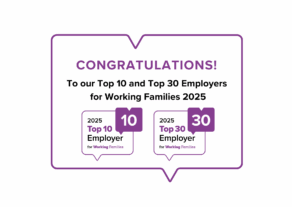The quiet revolution: how flexible working has gone from perk to strategic priority
Published: 24 Nov 2025

The 2025 Working Families Benchmark has revealed that in the years following the pandemic, flexible working has moved from being a fringe benefit to being part of business strategy. Back in 2020, just 2 in 10 (22%) staff working at our ‘best practice’ Benchmark employers worked flexibly. Just half a decade later, 71% of organisations say that more than three-quarters of their workforce are working flexibly. This includes not only remote and hybrid working, but also options such as part-time roles, compressed hours, job shares, term-time working, and variable start and finish times. Small and medium enterprises have a particularly successful story to tell, having been much less likely to have staff working flexibly in 2020, now at least 75% of every single SME Benchmark employer works flexibly.
This remarkable jump in such a short time represents a transformation akin to a revolution in how flexible working is perceived. What was previously considered a perk, or something restricted to certain roles or circumstances, has entered the mainstream. Helped in no small part by the unique circumstances of the pandemic, the trend is going nowhere. This is evident in the finding that, over the past five years, between 96% and 98% of organisations have strategic plans in place to support flexible working.
It’s no wonder employers are embedding flexible working in their business strategy when you consider the measurable benefits they report. This year’s figures show half of employers have seen an increase in productivity, and almost half (47%) are enjoying lower staff turnover as a result of flexible working. No longer are employers treating flex as an add-on, but rather they are leveraging its benefits for strategic returns, including being part of the solution to reduce the gender pay gap. 8 in 10 employers plan to address their gender pay gap by advertising roles with flexible options and 8 in 10 ask leaders to role model working flex. However, only 55% actively encourage men to work flexibly, which chimes with findings in our Barriers to Equal Parenting research that found men are often nervous to ask for flex.
In fact, the Benchmark report highlights there is still some way to go before the benefits of flexible working can claim to be universal. Specifically, valuing part-time work as highly as full-time, translating policy into culture, expanding the range of types of flexible working, investing in line-manager training and designing roles with a flexible element can help ensure all parents and carers in all types of jobs can access the flex they need.
Jane van Zyl, CEO of Working Families said:
Our Benchmark employers have always had one eye on what’s best for business as well as what is right for their people, and the latest report shows that, with flexible working, they are one and the same thing.
With 78% seeing flexible working as a tool for improving effectiveness and 96% saying they can rely on colleagues to deliver on commitments, these employers understand the value of true flexibility rooted in trust and autonomy. With the Employment Rights Bill around the corner, they are way ahead, showing what can be gained when you make flexible and family-friendly working strategically imperative.

Benchmark Report 2025
In this year’s Benchmark report, we explore how the world of work has changed for Benchmark employers across the last five years, as well as throwing a detailed spotlight on best practice amongst this year’s Benchmark participants.

The Working Families Benchmark
Measure your practices against best-in-class employers and gain recognition as a top performer.

The Top 30 Employers in 2025
Find out more about who made it onto our annual list of the top flexible and family-friendly employers in the UK.